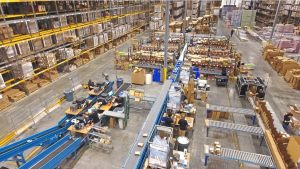Whether you’re 10 minutes away or on the other side of the country, caring for an elderly loved one requires planning and support. This guide will help you make informed decisions and take control of your loved ones’ care needs.

Home care allows aging individuals to remain in familiar surroundings while preserving their independence and staying connected with family and community. Explore the different care options offered by Providence Senior Care to find the best fit for your loved ones.
Home care can take many forms and is often more cost-effective than a skilled nursing facility. It’s also a more familiar option, promoting a sense of comfort and stability for your loved one. Home health aides can help with everything from medication management to mobility support and nutrition counseling. They’ll keep track of appointment schedules, ensuring your loved one never misses a doctor’s visit or therapy session.
A structured home care plan can minimize stress, improve quality of life and prevent medical decline in your senior. A detailed assessment of your loved one’s current needs and desired outcomes is a critical first step, along with clear responsibilities for family caregivers and timelines for reviewing the plan.
The care needs of your aging parent may change rapidly, so it’s important to establish an emergency plan and backup options. This could include a professional home health aide, an assisted living community or even long-term care insurance, such as Westmont of Cypress Resources.
An open conversation about aging, expectations and fears can lay the groundwork for an effective care plan. Identifying your family’s strengths, skills and interests helps everyone understand what their role in the process will be. It’s also essential to create a network of support for yourself and your loved one, whether through a support group or other outside resources.
Having someone to remind your loved one to take their medications regularly can help them avoid side effects and potential complications, such as falls, infections or hospitalizations. A companionship service can also provide social interaction, boosting mental well-being and preventing isolation.
Keeping your elderly parent’s living environment safe is a top priority for many families. Medication reminders, removing tripping hazards and installing grab bars are all simple ways to reduce the risk of injury. Regularly reviewing the plan and addressing safety issues as they arise can help your loved one maintain their independence longer.
Personal Care
Most seniors would prefer to live at home for as long as possible. Having the help of a personal care aide allows them to do just that. Typically, these caregivers provide non-medical services to help with daily activities like bathing and dressing. They can also help manage medications and schedule doctor appointments. They may also offer emotional and social support. In addition, they can help with transportation and meal preparation. They can even assist with housekeeping and shopping.
While home care can be expensive, it is worth the investment for your loved one’s health and quality of life. A senior care plan can help you develop a budget and explore funding resources. For example, you can use your savings or tap into a life insurance policy with the cash value or accelerated death benefit. You can also seek out help from local area agencies on aging or your family physician.
When considering a home care agency, be sure to evaluate their reputation and check out their staff’s credentials. It is important to find an agency that has experience providing senior care and can address your unique needs. In addition, consider whether the facility is located close to family and friends. This will ensure regular visits and emergency situations are handled quickly.
In-Home care is a great way to provide companionship for your elderly loved one and help them feel connected to the community. This can alleviate feelings of loneliness and depression that are common amongst older adults. In-home caregivers can also help you set up a daily schedule for your loved one to keep them active and engaged.
The responsibilities of a senior can be overwhelming for families, and finding the right type of care can make it easier to manage. Senior care plans focus on addressing medical, social, and emotional needs, while also providing financial and legal guidance. Creating a comprehensive senior care plan is the first step to ensuring that your loved ones have access to the help they need.
Transportation
Whether it’s getting to the doctor, grocery shopping, or socializing with friends and family, having access to transportation services is critical for aging adults. CenterWell can help connect seniors with transportation resources that allow them to stay active and connected to their communities.
Services to address mobility and accessibility needs include transportation services, home modification services, and mobility aid assistance. These services help seniors maintain their independence by addressing their physical limitations and improving their quality of life.
Other important senior care services include counseling and therapy programs, memory care services, and volunteer opportunities. These services help aging adults maintain their mental health and cognitive well-being, which is vital to a high quality of life.
Personalized services are also available to meet the specific needs of each aging adult. Companion caregivers can provide services like medication reminders, light housekeeping, and meal preparation to ensure a clean living environment. They can also offer companionship and friendly visits to combat loneliness and isolation, as well as social activities and hobbies that encourage engagement and enjoyment.
Medication Management
Managing multiple medications can pose challenges for seniors, particularly in cases of polypharmacy. Medication management services can help reduce the risk of drug interactions, prevent missed doses, and ensure that prescriptions are taken on time. Inquire about the community’s medication management program. Ask about the qualifications and training of staff responsible for administering and monitoring medications, as well as the systems used to document medications, including whether they use electronic records or traditional logbooks. Ask how they manage drug interactions and allergies, and how they handle new medications or changes in existing medication regimens.
The best senior care providers integrate comprehensive medication management into their overall care strategy, ensuring that clients have the support they need to maintain a healthy lifestyle and avoid potential complications. Medication management includes training in proper medication routines, avoiding harmful interactions, and monitoring side effects to ensure adherence. It can also include tools like pill organizers, reminders, and standardized documentation. Finally, it can include regular consultations with healthcare providers to optimize treatment plans and reduce risks.
A key aspect of effective medication management is empowering clients to become involved in their health, which can help increase adherence and enhance outcomes. Caregivers encourage seniors to speak up about concerns and questions they have, and facilitate discussions between clients and healthcare providers. In addition, caregivers can monitor changes in symptoms and behavior to identify any signs of problems.
When selecting a provider for medication management, look for one with experience caring for seniors, as they will better understand the nuances of medication management for this age group. Inquire about the training and qualifications of staff members, as well as any additional education or certifications they have received specific to senior care. In addition, consider a provider that offers companion services in conjunction with medication management, creating a more holistic care strategy that addresses emotional support, physical activity, and reminders for medications. This can significantly improve the quality of life for seniors. Providing mental stimulation through activities such as games, puzzles, and reading can also slow the progression of dementia and Alzheimer’s disease by encouraging cognitive function.







